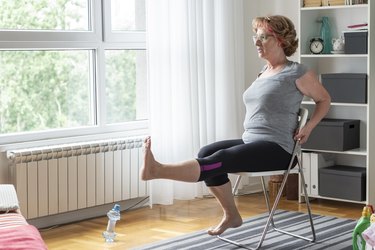
Mobility training is a lot like flossing your teeth. It's no one's favorite part of their self-care routine, but the practice will keep you pain-free in the long run.
Although mobility training is important for everyone, it's a big factor in staying injury-free as you get older. And there are specific exercises you want to focus on during the different decades of your life. Learn which mobility moves to prioritize in your 50s, 60s, 70s and beyond.
Video of the Day
Video of the Day
The 3 Best Mobility Moves for Your 50s
Once you've hit your 50s, you should focus on left and right spinal mobility, says Sam Becourtney, PT, DPT, a physical therapist at Bespoke Treatments in New York.
"Adults in their 50s should be able to get up and down from the ground more easily than older adults," Becourtney says. "So, it's important to take advantage of this age window and utilize stretches that may be more difficult when getting older."
As you run through these exercises, focus on using your breath to gently deepen the stretches, gradually building your flexibility.
Move 1: Child's Pose
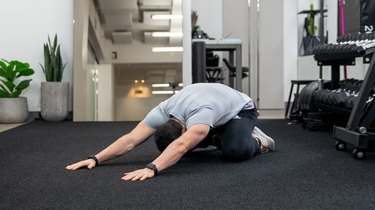
- Start kneeling and sit your butt back toward your heels.
- Stretch your arms out in front of you on the floor.
- Rest your head between your arms.
- Hold here for 30 seconds.
Move 2: Prone Press-Up

- Lie down on your stomach with your elbows bent and hands by your armpits.
- Gently press into your palms and lift your chest a few inches off the ground, keeping your hip bones rooted.
- Hold here for 5 to 10 seconds.
- Reverse the motion gently and come back to the ground.
Tip
As your chest and back open up, try to raise the chest a little bit higher off the ground with each repetition.
Move 3: Cross-Body Shoulder Stretch
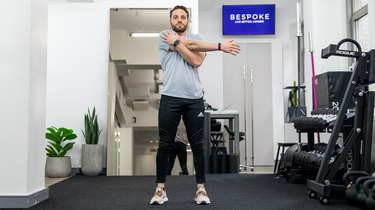
- You can either sit in a comfortable position on a chair or stand up.
- Reach your left arm across your chest.
- With your right arm, grasp your left arm just behind the elbow.
- Gently pull your left arm across your body.
- Hold here for 5 to 10 seconds.
- Relax and repeat on the other side.
The 4 Best Mobility Moves for Your 60s
Generally, people in their 60s begin to get joint replacement procedures, including total hip and knee replacements, Becourtney says, so this is when you really want to emphasize building mobility in these joints.
As you practice these exercises, keep the movements small at the beginning until you're comfortable enough to deepen the stretches. Also, use a chair or wall to help you balance when doing single-leg exercises, Becourtney recommends.
Move 1: Standing Quad Stretch
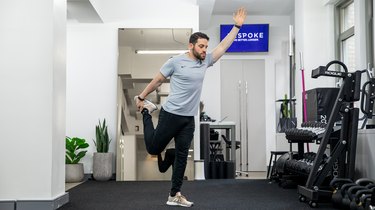
- Stand with your feet hip-width apart, using a chair or wall for balance, if needed.
- Bend your left knee and raise your left heel.
- Take hold of your left foot with your left hand.
- Slowly and gently pull the leg back and bring your left foot toward your butt.
- Hold here for 10 to 15 seconds before you slowly release your leg.
- Repeat 3 to 5 times on each leg.
Tip
As you perform this exercise, keep your core engaged and avoid arching your lower back, Becourtney says. If you feel your lower back arching, don't pull your heel up as high.
Move 2: Foot on Chair Hamstring Stretch
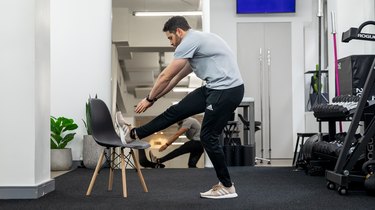
- Place your left foot on a chair with your leg extended, foot flexed.
- Gently reach toward the foot with both hands until you feel a stretch in the back of your leg. Hinge forward from the hip, keeping the spine straight.
- Hold here for about 30 seconds before you release the tension.
- Switch legs and repeat for 2 to 3 rounds on each leg.
Tip
If you can't reach your toes, you can place your hands on your shin or thigh but avoid grasping your knee directly.
Move 3: Quadruped Hip Capsule Stretch
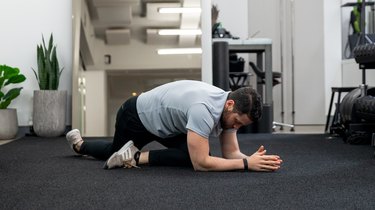
- Start kneeling with your forearms on the ground and your shoulders over your elbows, hips over your knees.
- Straighten your left leg behind you and cross it over your right foot.
- Slightly rotate your left foot toward the midline of your body.
- Push your left foot through your hands.
- Gently bring your butt back toward your heels.
- Hold here for 20 to 30 seconds.
- Repeat the stretch 2 to 3 times on each leg.
Warning
If you have osteoporosis, talk to your doctor before trying this move — or before you start any new exercise routine.
Move 4: Lateral Line Stretch on Wall

- Stand in front of a wall with your feet hip-width apart.
- Reach your hands overhead and off to the left, flat against the wall.
- Keeping your feet stationary, shift your hips to the right.
- Cross your right foot behind your left leg.
- Hold here for 20 to 30 seconds.
- Repeat for 3 rounds on each side.
The 4 Best Mobility Moves for Your 70s and Beyond
Adults within this age range are likely less mobile and will have a little more trouble getting down on the floor and coming back up.
"We spend more and more time seated as we get older, so it will be beneficial to use the time in a chair for stretching," Becourtney says. "[Sitting in a chair] is likely more comfortable and creates less concern for the loss of balance."
Warning
If you have a pre-existing condition related to the lower back, make sure to consult a medical professional before trying any new exercises, Becourtney says. If you feel pain or discomfort during any of these movements, stop the exercise immediately.
Move 1: Seated Thoracic Extension

- Sit in a chair with your feet flat on the ground and knees bent at 90 degrees.
- Place your hands behind your head.
- Bring your elbows close to the midline of your body.
- Slowly bend backward and extend your upper body across the back of the chair.
- Hold for 2 to 3 seconds.
- Relax and return to the upright position.
- Repeat this motion 5 to 10 times.
Move 2: Seated Spinal Rotation
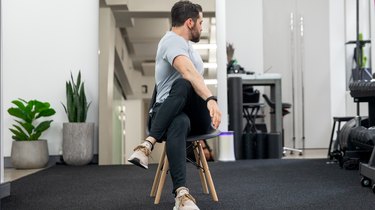
- Sit in a chair with your knees bent at 90 degrees and feet flat on the ground.
- Cross your left leg over your right leg.
- Take hold of your left knee gently.
- Rotate your torso toward the left and hold for 15 to 20 seconds.
- Release the stretch and repeat for 2 to 3 rounds on each side.
Move 3: Seated Hamstring Stretch
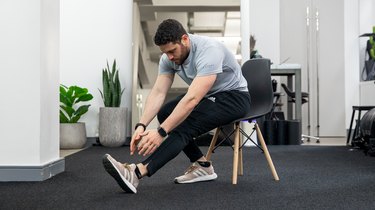
- Sit in a chair with your feet flat on the ground and knees bent at 90 degrees.
- Straighten your left knee in front of you, heel down and toes facing up.
- Reach your hands gently toward that foot, allowing your spine to fold.
- Hold here for 10 to 15 seconds.
- Return to the starting position.
- Repeat on the opposite side for 2 to 3 rounds per leg.
Tip
If you can't reach your foot on the ground, you can place your hands either on your shin or thigh but avoid grabbing your knee.
Move 4: Sit to Stand
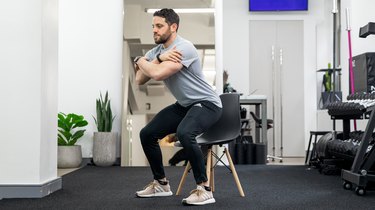
- Stand in front of a chair with your feet hip-width apart and arms crossed in front of your chest or down by your sides.
- Slowly bend your knees and push your hips back, lowering your body.
- Slowly lower toward the chair until you come into a comfortable seat.
- When you're ready, press into your heels, push your hips forward and reverse the motion to come to standing.
- Repeat for 10 reps and 2 rounds.
Tip
"Although this is technically more of a strengthening exercise, this is an absolute must for all older adults," Becourtney says. "As we get older, it will become more and more difficult to get up out of a chair, whether this is due to tightness or weakness." If you're a little unstable, hold onto a nearby countertop or other sturdy piece of furniture.